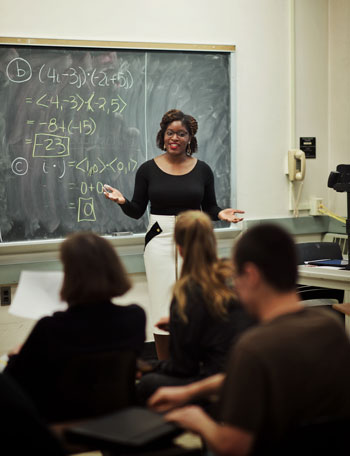As is the case for most new teaching assistants, Ranthony Edmonds recalls the worry associated with teaching her first course at the University of Iowa.
“I wanted to do a good job and provide my students with a good experience, but I honestly wasn’t exactly sure how to execute that,” Edmonds says.

Edmonds, a Dean’s Graduate Fellow, decided to make a concerted effort to improve her teaching by participating in the myriad of teaching-related development programming at the UI, including opportunities offered through the Center for Teaching.
During one teaching development opportunity, she recalls how the Center for Teaching told her about a national, teaching-focused, development program called CIRTL (Center for the Integration of Research, Teaching and Learning) that was going to be launched by the Graduate College during the summer of 2016.
The UI’s CIRTL Program is among 43 nationally-recognized STEM teaching-development efforts housed in institutions of higher education across the country. The program is built on the CIRTL core ideas: teaching as research, learning communities, and learning through diversity.
CIRTL stresses the use of evidence-based practices to help STEM teaching assistants educate undergraduate students from all backgrounds. CIRTL employs a three-tier model of teaching development, which progresses from associate to practitioner to scholar.
Edmonds wasted no time becoming actively involved in CIRTL. During the 2016-17 academic year, the native of Lexington, Ky., met all the requirements to become a CIRTL Associate, and then developed a teaching-focused research topic to investigate as she pursued the practitioner level.
CIRTL Associate
Edmonds achieved this status by completing five teaching-focused, professional development opportunities. The enthusiasm and commitment she displayed was recognized early by the CIRTL leadership. She was offered the opportunity to serve as a CIRTL ambassador, a role that required her to promote the CIRTL Program across the UI campus via presentations and workshops.
“We’re getting teaching assistants (TAs) to become more intentional with their teaching,” says Edmonds, who received both a Graduate Teaching Fellowship from the Center for Teaching and a Teaching-as-Research (TAR) Fellowship from CIRTL in 2016-17. “Within their disciplines, TAs are starting to think critically about challenges, and making concerted efforts to address those challenges.”
CIRTL Practitioner
CIRTL participants can reach the practitioner level by creating a Teaching as Research (TAR) project designed to research their teaching practices. Edmonds’ TAR project was titled, “A Partially Flipped Model for a College Trigonometry Course.”
Edmonds conducted one day of flipped instruction, meaning she delivered instructional content to students who were outside of the classroom through videos she created, and two days of a traditional in-class lecture. She also created weekly video quiz assessments (11 total quizzes) based on her instructional videos. Students then completed an anonymous survey that measured their perceptions of the utility of the flipped model and their own learning.
“Being able to do a TAR project is great,” Edmonds says. “You’re able to go to your next academic institution as a faculty member with evidence outside of course evaluations that you can quantitatively demonstrate the effectiveness of your teaching.”
CIRTL Scholar
CIRTL participants attain the scholar distinction by presenting their education research nationally or regionally.
Edmonds gave a poster presentation about her research on a partially flipped classroom at the Mathematical Association of America’s MathFest in Chicago last July. She also plans to give another talk about her TAR project at the Joint Math Meetings in San Diego this January. This meeting is the largest annual event for mathematicians in the world.
She learned a lot about herself as a teacher by presenting at the first conference.
“Before I did CIRTL, I would teach a class and that would be it,” says Edmonds, who plans to earn her Ph.D. in the spring of 2019. “I never intentionally looked back on how I could make the class better. CIRTL has empowered me to be more intentional about the way I teach, the way I think about teaching, and the way I evaluate my effectiveness.”